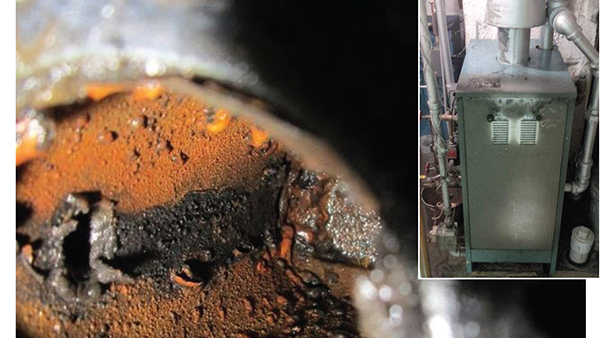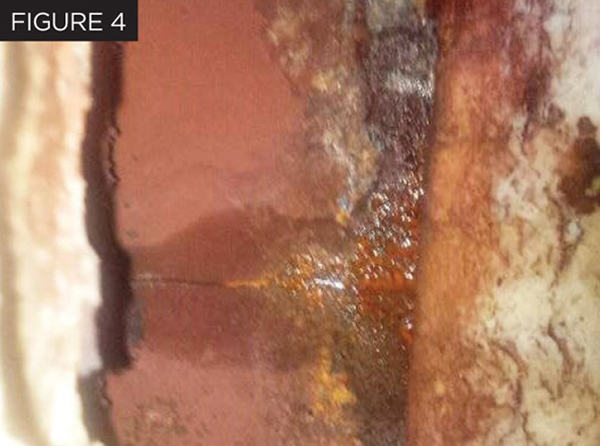Understanding HVAC Diagnoses – Acidic Refrigerant
Year after year, lightning is consistently the most frequently claimed peril for HVAC systems in homeowner’s claims, and it is also the most often misdiagnosed cause of loss, according to the HVACi 2018 Annual Claims Report. One symptom that is regularly misinterpreted as lightning damage is acidic refrigerant in the system.
Contrary to popular belief among contractors, it is not possible for lightning to cause acid in the refrigerant circuit of an HVAC system. Instead, this symptom is caused by one of three conditions: wear and tear, improper repairs, or a lack of system maintenance. Because this common misconception is often cited as an indicator of lightning damage, it is important for adjusters to understand why this is not the case.
The oil from a compressor was drained during destructive testing and tested positive for acid
What Causes Acidic Refrigerant
When the refrigerant circuit is subjected to moisture, excessive heat, contaminants, or other impurities, it leads to a chemical reaction that creates acid. This condition is brought about by age (ordinary wear and tear), a lack of maintenance, or an improper system repair. As a system ages, leaks can develop in the copper coils that contain the refrigerant, providing an point of entry for outside contaminants. Additionally, the compressor’s components can break down due to age, introducing impurities into the refrigerant. Once contaminants or moisture enter the refrigerant loop, the resulting chemical reaction will create acid. Acidic refrigerant can also occur when the system overheats due to a clogged coil or a failed condenser fan. Excessive heat caused by this lack of airflow can accelerate the creation of acid within the refrigerant. Finally, when a compressor burns out because of the presence of acidic refrigerant and is ultimately replaced (but the lineset is not properly flushed or a new filter drier is not installed) acid may be reintroduced into the new compressor, leading to another burnout.
A clogged coil can lead to elevated temperatures and accelerate the creation of acid
Organic vs. Inorganic Refrigerant Acids
Depending on the type of chemical reaction, the acid generated will be either organic or inorganic in nature. The type of refrigerant, oil composition, and the type of contaminant all influence this reaction. While both types of acids are destructive to compressors, the types of damage they cause are very different.
One factor in determining the composition of the acid produced is the combination of refrigerant and oil. Hydrochlorofluorocarbon (HCFC) systems, such as those that contain the refrigerant R-22, typically use mineral oil to lubricate the systems. When moisture or contaminants enter these systems, the refrigerant breaks down, because the natural lubricating oil is more stable than its accompanying refrigerant. This results in the creation of an inorganic acid. Such acids result in abnormally high temperatures in the motor windings and/or discharge area of the compressor. These high temperatures break down the windings and lead to the loss of electrical resistance of the compressor, or a compressor burnout.
The above compressor motor windings were damaged by compressor burnout due to acidic refrigerant
Conversely, R-410a and other hydrofluorocarbon (HFC) systems use a polyolester (POE) lubricating oil, which has a very different chemical structure from HCFC/mineral oil systems. While the refrigerant itself is more stable, the oil composition is less stable and can break down easily in the presence of moisture, air, or high temperatures. When POE oils (as opposed to the refrigerant) break down, the resulting chemical reaction leads to the formation of organic acids rather than inorganic acids. Instead of leading to compressor burnout, organic acids typically create a sludge that can clog small valves or cause the oil to lose its ability to properly lubricate the compressor. When this occurs, the compressor will seize.
This system tested positive for acidic refrigerant
Regardless of composition, HFC (R410a) and HCFC (R22) systems still run the risk of developing inorganic acids that can burn out the compressor. This can occur when contaminants and impurities (those not moisture, air, or excessive heat) enter the refrigerant system. If contaminants (such as metals from the degeneration of the compressor) enter the system, an inorganic acid will form, leading to compressor burnout.
What does this mean for adjusters?
As an adjuster, you should always be on the lookout for any clues that a claim may need further investigation. It is critical that you understand what signs could be “red flags” when reviewing claims for complex equipment such as HVAC systems. A contractor’s attestation that points to acidic refrigerant as an indicator that a system has been damaged by lightning should always prompt a deeper discussion.
If you have a claim involving lightning damage to HVAC equipment, and you want to ensure an accurate settlement, you can submit your new claim here.


































